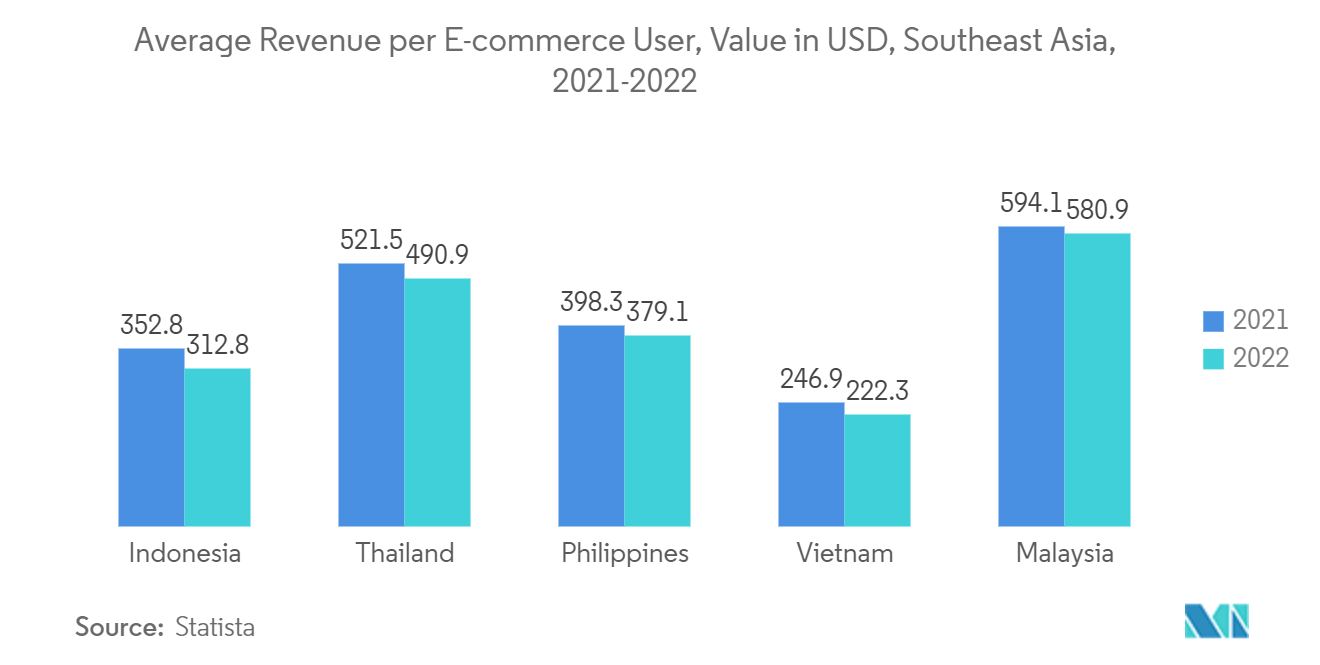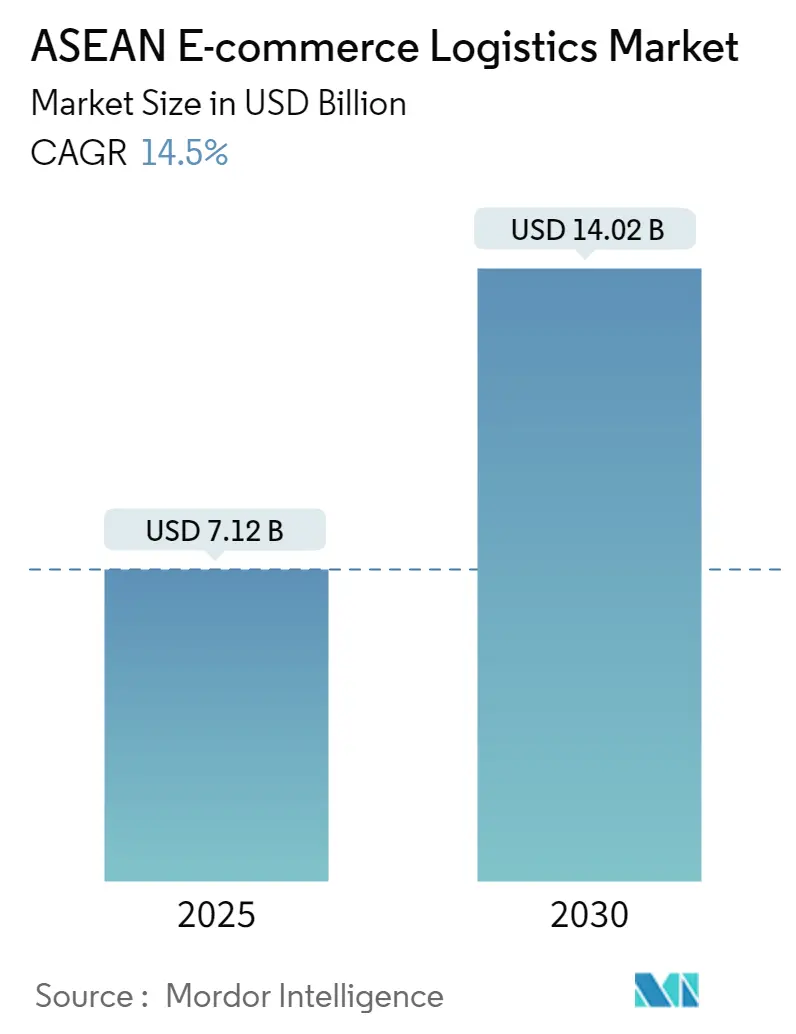
| Study Period | 2019 - 2030 |
| Base Year For Estimation | 2024 |
| Forecast Data Period | 2025 - 2030 |
| Market Size (2025) | USD 7.12 Billion |
| Market Size (2030) | USD 14.02 Billion |
| CAGR (2025 - 2030) | 14.50 % |
| Market Concentration | Low |
Major Players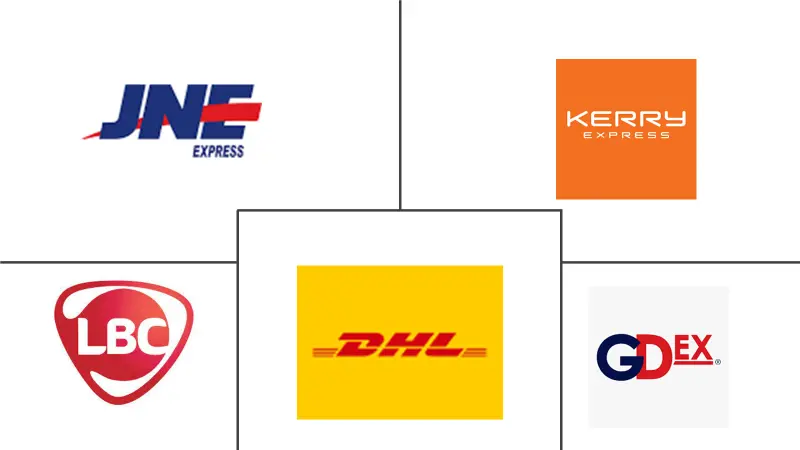
*Disclaimer: Major Players sorted in no particular order |
ASEAN E-commerce Logistics Market Analysis
The ASEAN E-commerce Logistics Market size is estimated at USD 7.12 billion in 2025, and is expected to reach USD 14.02 billion by 2030, at a CAGR of 14.5% during the forecast period (2025-2030).
When COVID-19 caused a surge in e-commerce throughout Southeast Asia, delivery companies struggled to sustain and expand their success. Southeast Asia's internet retail value increased from USD 495 billion to an estimated USD 581 million. Warehouses were typically 1,000 sq. mt. in size, but demand was for multi-level warehouses that could be 10,000 or 15,000 sq. mt.
Southeast Asia is poised for rapid growth in e-commerce. Five Southeast Asian countries are among the world's fastest-growing e-commerce markets, accounting for half of the top ten. Southeast Asia was previously an e-commerce laggard, digitally overshadowed by China and Japan. However, nearly all of them now have mobile devices and, as a result, internet access. The five countries' mobile penetration rates are all close to 100%.
According to industry sources, Malaysia has a population of 32.8 million people. E-commerce sales in the base year were USD 6.3 billion, up 15% from the previous year. Shopee is the most popular marketplace, followed by PGMall, a local platform that collaborates with JD. The most popular marketplaces are JD, Shopee, and Lazada. The main product categories are electronics and personal care.
Even though the rapid growth of e-commerce is driving logistics development in this market, this remains a challenge for a few countries with complex topography in Southeast Asia. Logistics operation management is a challenge for e-commerce businesses. As economies recover from the global pandemic and income levels rise, the intra-Asian market is expected to expand, with a corresponding increase in demand for express logistics services propelled by the thriving e-commerce sector.
ASEAN E-commerce Logistics Market Trends
E-commerce growth is driving the market
Southeast Asia is experiencing a surge in e-commerce. Consumer trends in the region are creating exciting opportunities for online retailers looking to expand due to massive growth in the digital payments sector. Among product categories, electronics are the most popular in the region. TVs, smartphones, laptops, USB drives, power banks, and other items are among the best-sellers in this category.
On the other hand, clothing, fashion accessories, baby products, and furniture are not far behind, with Southeast Asian markets experiencing higher-than-ever sales in these segments. Live streaming for e-commerce platforms is rapidly expanding in the Southeast Asian market. Statistics show live streaming hours on e-commerce platforms increased by 200% in Malaysia and Singapore. The trend spread to the Philippines, where 60% of brands use live selling to attract more customers to their stores.
The support of social commerce, internet penetration, and demand for some product categories drives the growth of e-commerce in ASEAN countries. The online channel has created a huge opportunity for domestic retailers in various countries. Even though these countries lag in infrastructure and logistics services, the demand for products through the channel is luring investors to dive deeply into the market.
Infrastructure development in south-east Asia supporting the market
The growing global interest in Southeast Asia's infrastructure needs has been exciting and concerning for developing countries. The G7 announced its support for the US-led 'Build Back Better World' (B3W) initiative in 2021, while the European Union unveiled its infrastructure strategy, dubbed 'Globally Connected Europe.'
These initiatives aim to address developing countries' USD 40 trillion infrastructure gap, but they also raise geopolitical concerns by appearing to compete with China's Belt and Road Initiative. Southeast Asian governments do not want to be caught in a geopolitical crossfire over investment decisions. Apart from the massive amounts of capital required, infrastructure in developing Southeast Asian countries suffers more due to poverty and the ever-present threat of climate change. While the infrastructure has improved, more is needed. The majority of the population lacks access to electricity, safe drinking water, and safe roads.
Cities with poor planning and traffic congestion alone cost them a daily loss of productivity, wasted fuel, and increased stress. In addition, the International Monetary Fund (IMF) discovered that countries waste roughly one-third of their infrastructure spending due to inefficiencies.
Meanwhile, in 2023, Southeast Asia witnessed an increasing number of investments in the infrastructure sector. For instance, in March 2023, the Asian Infrastructure Investment Bank (AIIB) granted more than USD120 million to the Seraya Southeast Asia Energy Transition and Digital Infrastructure Fund (the Fund). This investment is aimed at enhancing the region’s transition to green energy and technology-enabled infrastructure development, which is also expected to improve cross-border digital connectivity within Asia. Moreover, in February 2023, A.P. Moller Group planned to invest more than USD 750 million in various infrastructure platforms in South and Southeast Asia. Thus, the growing infrastructure sector in the region is expected to create a huge opportunity for e-commerce logistics service providers.
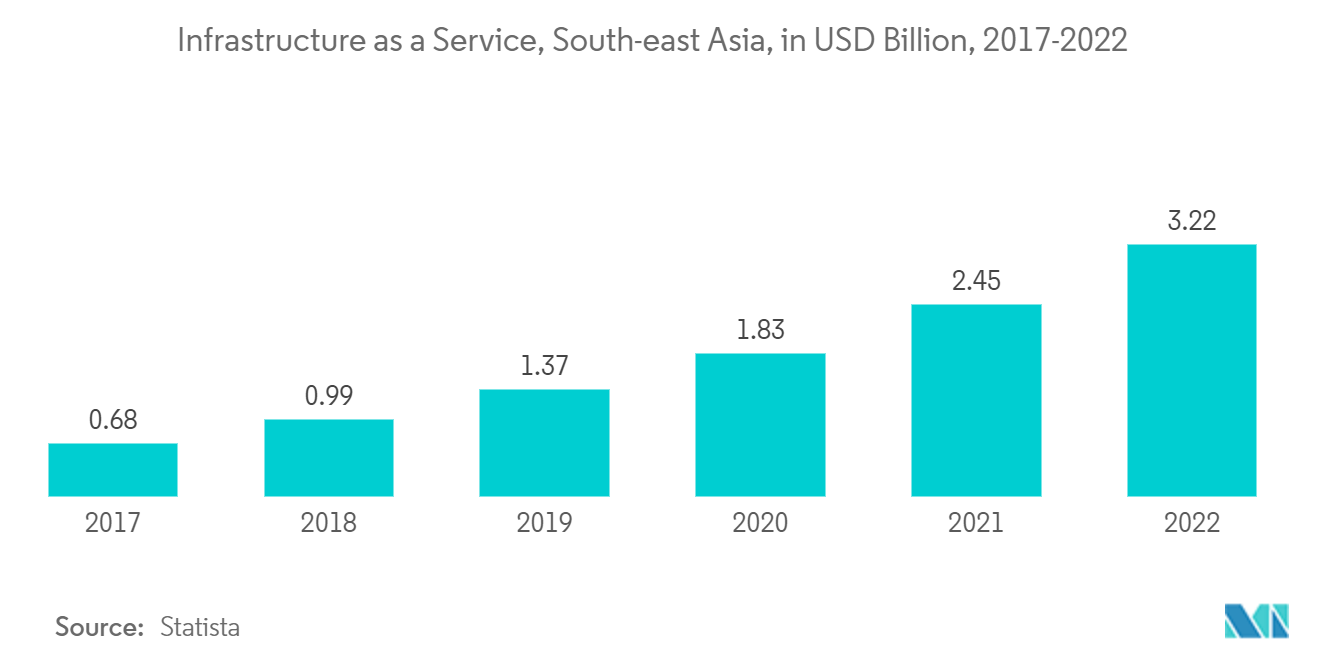
ASEAN E-commerce Logistics Industry Overview
The ASEAN e-commerce logistics market landscape is fragmented as the demand for logistics services is growing rapidly across the region, and companies are becoming more competitive to capture this opportunity. As a result, international players are making strategic investments to establish a regional logistics network, such as opening new distribution centers and smart warehouses. Some leading players include JNE Express, LBC Express, GD Express, Kerry Express, Ninja Van, and Best Express. To maintain cost competitiveness, companies that operate online prefer to work with third-party courier providers instead of hiring in-house delivery staff. As a result, global companies are actively investing in targeting growth opportunities in the region.
ASEAN E-commerce Logistics Market Leaders
-
JNE Express
-
GD Express
-
LBC Express
-
Ninja Van
-
Kerry Express
- *Disclaimer: Major Players sorted in no particular order
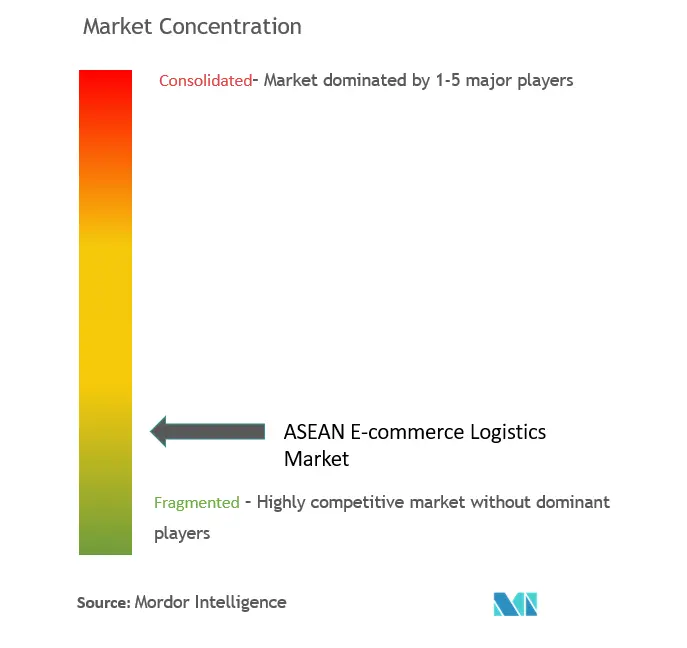
ASEAN E-commerce Logistics Market News
Mar 2023: Ninja Van Singapore (a logistics company) rolled out PR as a service for businesses shipping with Ninja Van in Singapore. The company will provide some of the services, including media release development, influencer management vent support, etc. The new service falls under the company’s value-added services division. In addition, the PR tool helps shippers to create brand recognition, build credibility, and manage brand reputation, thereby achieving shippers’ business goals.
Oct 2022: FedEx Express expanded its direct commercial presence in Cambodia as the Southeast Asian country's economic recovery accelerated, with exports increasing 20% yearly to USD 27 billion in the first half of the base year. FedEx continues to expand its presence and services in emerging Southeast Asian markets, such as Cambodia, to help small and medium-sized businesses grow.
ASEAN E-commerce Logistics Industry Segmentation
E-commerce logistics refers to the transportation service provided to the online retail market. A complete background analysis of the ASEAN e-commerce logistics market, including the assessment of the economy and contribution of sectors in the economy, market overview, market size estimation for key segments, and emerging trends in the market segments, market dynamics, and geographical trends, and COVID-19 impact is included in the report.
The ASEAN E-commerce Logistics Market is segmented By Service (Transportation, The report covers the ASEAN E-commerce Logistics Market Size and statistics. The market is Segmented By Service (Transportation, Warehousing and Inventory Management, and Value-added Services (Labeling, Packaging, etc.)), Business (B2B and B2C), Destination (Domestic and International/Cross-border), Product (Fashion and Apparel, Consumer Electronics, Home Appliances, Furniture, Beauty and Personal Care Products, and Other Products (Toys, Food Products, etc.)), and Country (Singapore, Thailand, Vietnam, Indonesia, Malaysia, Philippines, and the Rest of ASEAN). The report offers the market size in value terms in USD for all the abovementioned segments.
| By Service | Transportation |
| Warehousing and Inventory Management | |
| Value-added Services (Labeling, Packaging, etc.) | |
| By Business | B2B (Business-to-Business) |
| B2C (Business-to-Consumer) | |
| By Destination | Domestic |
| International/Cross-border | |
| By Product | Fashion and Apparel |
| Consumer Electronics | |
| Home Appliances | |
| Furniture | |
| Beauty and Personal Care Products | |
| Other Products (Toys, Food Products, etc.) | |
| By Country | Singapore |
| Thailand | |
| Vietnam | |
| Indonesia | |
| Malaysia | |
| Philippines | |
| Rest of the ASEAN |
ASEAN E-commerce Logistics Market Research Faqs
How big is the ASEAN E-commerce Logistics Market?
The ASEAN E-commerce Logistics Market size is expected to reach USD 7.12 billion in 2025 and grow at a CAGR of 14.5% to reach USD 14.02 billion by 2030.
What is the current ASEAN E-commerce Logistics Market size?
In 2025, the ASEAN E-commerce Logistics Market size is expected to reach USD 7.12 billion.
Who are the key players in ASEAN E-commerce Logistics Market?
JNE Express, GD Express, LBC Express, Ninja Van and Kerry Express are the major companies operating in the ASEAN E-commerce Logistics Market.
What years does this ASEAN E-commerce Logistics Market cover, and what was the market size in 2024?
In 2024, the ASEAN E-commerce Logistics Market size was estimated at USD 6.09 billion. The report covers the ASEAN E-commerce Logistics Market historical market size for years: 2019, 2020, 2021, 2022, 2023 and 2024. The report also forecasts the ASEAN E-commerce Logistics Market size for years: 2025, 2026, 2027, 2028, 2029 and 2030.
Our Best Selling Reports
ASEAN E-commerce Logistics Industry Report
Statistics for the 2025 ASEAN E-commerce Logistics market share, size and revenue growth rate, created by Mordor Intelligence™ Industry Reports. ASEAN E-commerce Logistics analysis includes a market forecast outlook for 2025 to 2030 and historical overview. Get a sample of this industry analysis as a free report PDF download.



